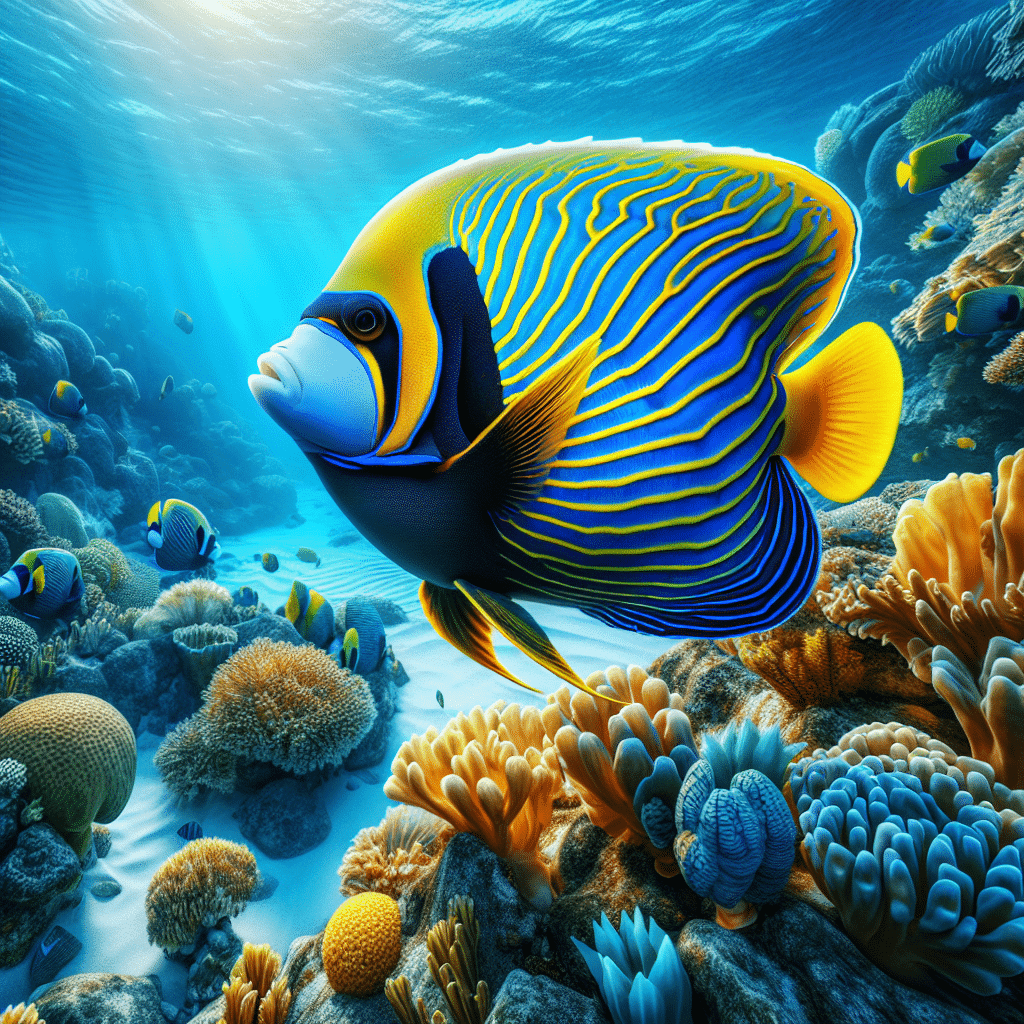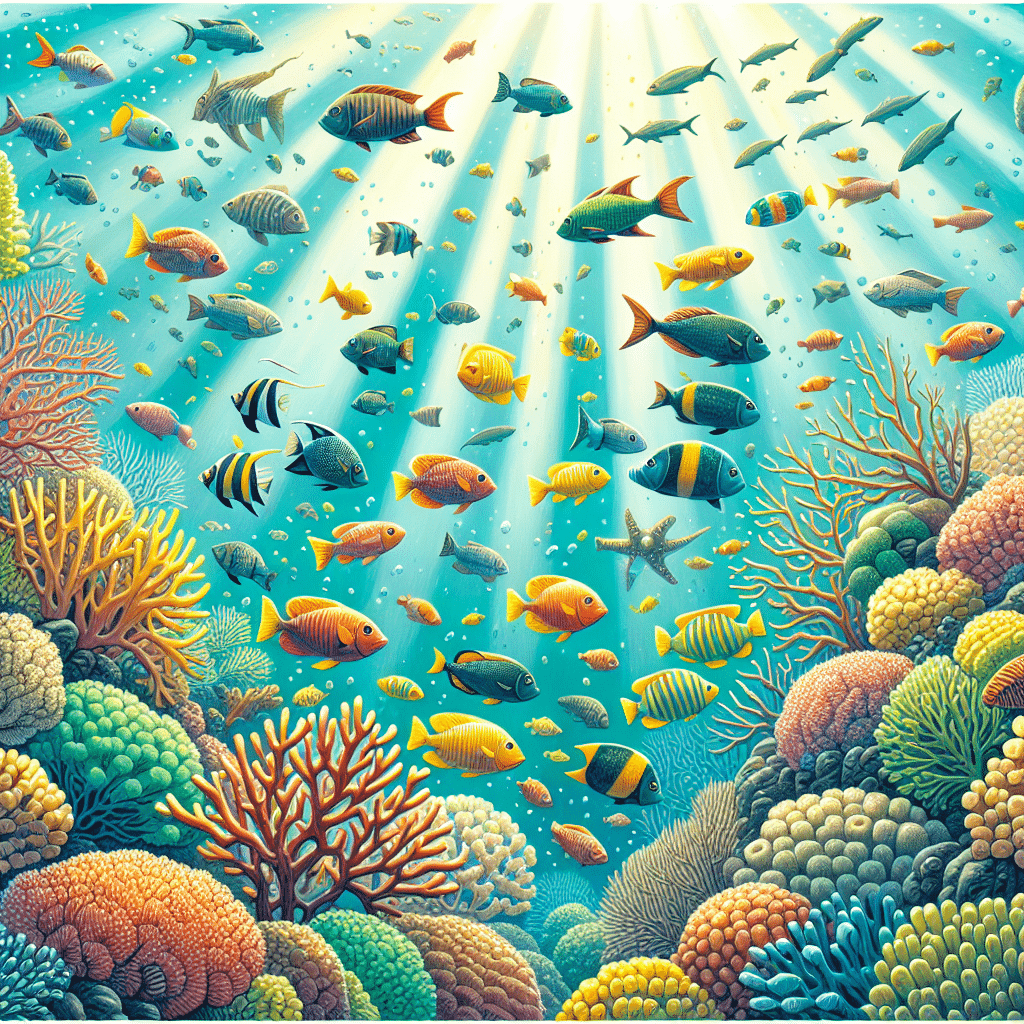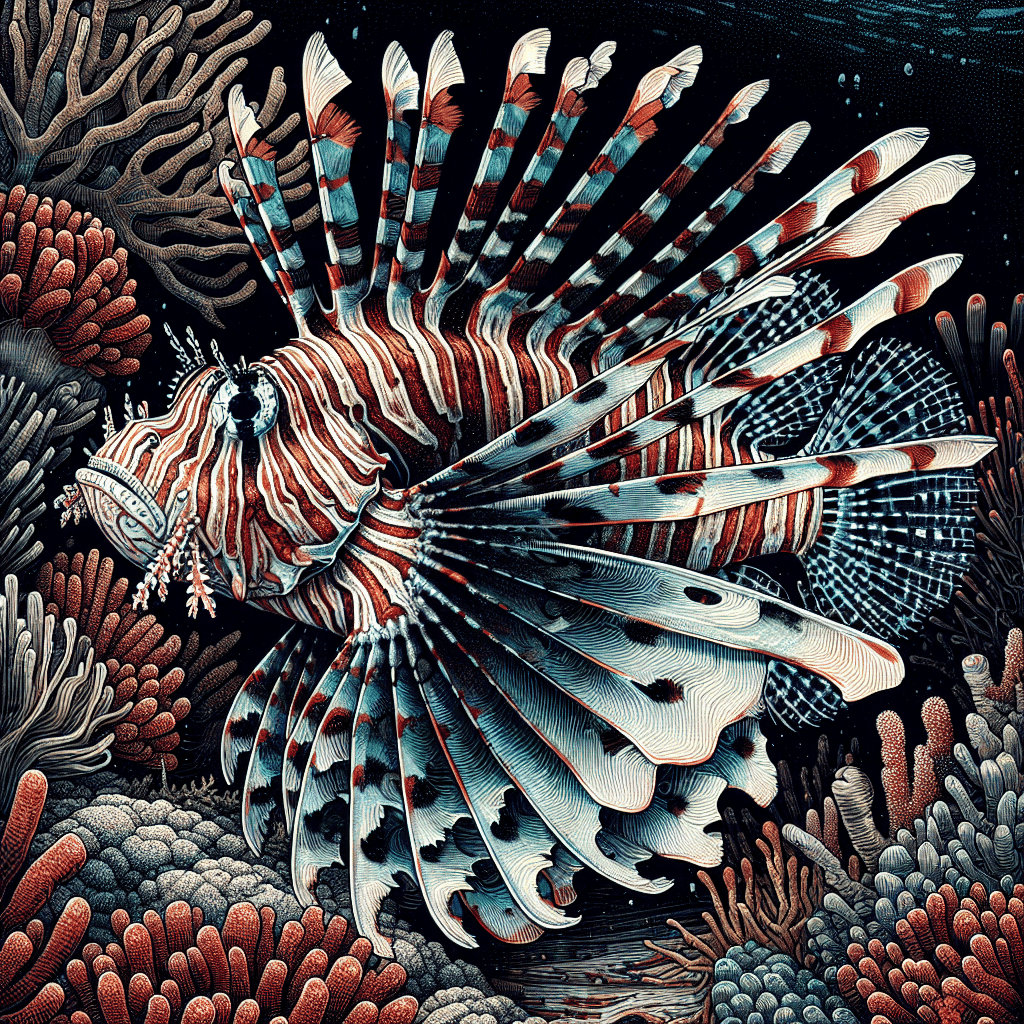Emperor Angelfish Overview
Appearance and Characteristics
The emperor angelfish (Pomacanthus imperator) is truly a striking addition to any reef tank. These fish can grow up to 15 inches long and are known for their beautiful coloration. Adult emperor angelfish display diagonal yellow and purplish-blue stripes along their bodies, complemented by a distinct curved black bar that covers one eye. Juveniles, on the other hand, have a dark blue-black color with a white ring on their rear, surrounded by incomplete circles of blue and white (Australian Museum).
Here’s a quick breakdown of their physical characteristics:
| Feature | Description |
|---|---|
| Maximum Length | Up to 15 inches |
| Adult Coloration | Yellow and purplish-blue stripes |
| Juvenile Coloration | Dark blue-black with white rings |
| Distinctive Markings | Curved black bar over the eye |
These features make them popular among divers and underwater photographers because of their regal appearance and graceful swimming style (Thailand Liveaboards).
Natural Habitat and Distribution
Emperor angelfish are native to the Indian and Pacific Oceans, ranging from the Red Sea all the way to Hawaii and the Austral Islands. They are typically found in reef-associated environments, which provide a stable habitat for their populations. Fortunately, this species is generally associated with stable populations and faces no major threats of extinction (Wikipedia).
When considering adding an emperor angelfish to your tank, it’s essential to replicate their natural habitat as closely as possible. Providing ample space, hiding spots, and decor that mimics a reef environment will help ensure their health and happiness in captivity.
Housing Emperor Angelfish
Creating a suitable environment for my emperor angelfish is essential to ensure their happiness and health. These fish have specific needs when it comes to tank size and setup, which I find important to consider as a hobbyist.
Tank Size Requirements
Emperor angelfish can grow quite large, reaching up to 15 inches in length. Because of this, I need to provide them with ample space. A minimum tank size of 180 gallons is recommended for a single emperor angelfish. This size allows them to swim freely and reduces stress, which is crucial for their well-being (Reef2Reef). For anyone considering keeping more than one, I suggest a larger tank to accommodate their territorial nature.
| Fish Size | Minimum Tank Size |
|---|---|
| Up to 15 inches | 180 gallons |
Tank Set-Up and Decor
Setting up the tank for my emperor angelfish involves creating a reef-like environment similar to their natural habitat in the Indian and Pacific Oceans. Here are some key components I focus on when decorating:
Live Rock: Adding plenty of live rock provides hiding spots and a natural environment for the fish. This rock also helps with biological filtration in the tank.
Coral: Since emperor angelfish are reef-associated, incorporating soft and hard coral can enhance their habitat. However, I need to ensure that the corals I choose are compatible with the angelfish.
Open Swimming Space: While I want to create hiding spots, I also ensure there is enough open space for swimming, as emperor angelfish are active swimmers.
Substrate: A sandy substrate mimics the ocean floor and allows for natural behaviors.
Water Flow: I consider the water flow in the tank. A gentle to moderate current helps mimic their natural environment, while also keeping the water oxygenated.
By carefully selecting the tank size and setup, I can create a thriving environment for my emperor angelfish. This not only enhances their beauty but also contributes to their overall health and longevity in my aquarium. For more tips on marine fish care, feel free to explore my other articles on marine fish.
Emperor Angelfish Behavior
Understanding the behavior of emperor angelfish is essential for anyone considering keeping them in their reef tank. Their territorial nature and unique courtship rituals are fascinating aspects of their lives.
Territorial Nature
Male emperor angelfish are known for their strong territorial instincts. They will fiercely defend their living space, which can extend to an impressive 10,760 square feet. This territoriality often leads them to confront other male emperor angelfish that venture too close to their domain (National Aquarium).
In my experience, these fish tend to spend most of their time swimming solo, as adult emperor angelfish rarely school together. They are protective of their environment and will not hesitate to chase away other fish that invade their space, making them a bold addition to any aquarium.
Courtship and Mating
When it comes to courtship, both male and female emperor angelfish exhibit a fascinating transformation. During the mating season, the female takes on a more bland color, while the male’s mask turns completely black, signaling his readiness to mate (National Aquarium).
The mating ritual typically occurs at dusk when pairs swim to the surface. Here, they release fertilized eggs that float away on ocean currents, a strategy that helps protect the eggs from potential predators (Thailand Liveaboards).
If you’re interested in adding emperor angelfish to your reef tank, understanding these behaviors will help you create a suitable environment that respects their natural instincts.
Emperor Angelfish Diet
Understanding the feeding habits of the emperor angelfish is crucial for keeping them healthy in an aquarium setting. As a hobbyist, I find it fascinating that these fish have unique dietary needs that reflect their natural behaviors.
Omnivorous Feeding Habits
Emperor angelfish are classified as omnivores, meaning they consume both plant and animal matter. In the wild, they primarily feast on sponges and marine algae, but they’re also known to nibble on small invertebrates and even parasites found on larger fish (National Aquarium, KidsZoo). Their strong jaws are specially adapted to chew through tough sponges, which form a significant portion of their diet.
Here’s a quick overview of their natural feeding habits:
| Food Type | Description |
|---|---|
| Sponges | Main dietary component; they prefer various types of sponges. |
| Marine Algae | Supplementary food source; helps provide essential nutrients. |
| Small Invertebrates | Occasionally consumed; adds variety to their diet. |
Ideal Diet in Captivity
To mimic their natural diet and ensure the emperor angelfish stays healthy in captivity, it’s vital to provide a balanced diet that includes both plant and animal-based foods. Here are some recommended feeding options:
- Sponges: While not always practical in home aquariums, sponge-based foods can be beneficial.
- Marine Algae: Offer dried seaweed or algae sheets as a staple food. I often use nori or spirulina-based products.
- High-Quality Pellets: Look for pellets specifically formulated for marine omnivores. These often contain a mix of proteins and plant matter.
- Frozen Foods: Small marine invertebrates, such as mysis shrimp or brine shrimp, are excellent sources of protein and should be included regularly.
- Live Foods: Occasionally providing live foods can stimulate natural hunting behavior, which is great for their mental health.
Here’s a sample feeding schedule that I follow:
| Feeding Time | Food Type | Frequency |
|---|---|---|
| Morning | Algae sheets | Daily |
| Afternoon | High-quality pellets | Daily |
| Evening | Frozen or live foods | 2-3 times a week |
By maintaining this diverse diet, I’ve found that my emperor angelfish thrive and exhibit vibrant coloration and healthy behaviors. Always remember to monitor their feeding habits and adjust portions to avoid overfeeding, which can lead to health issues. For more insights on marine fish care, check out our article on marine fish.
Emperor Angelfish Care Guide
Caring for my emperor angelfish requires attention to water parameters and tank mates compatibility. These aspects are essential for keeping my fish healthy and happy.
Water Parameters
Maintaining the right water parameters is crucial for the well-being of emperor angelfish. They thrive in stable conditions that mimic their natural habitat. Here’s a quick rundown of the ideal water conditions:
| Parameter | Ideal Range |
|---|---|
| Temperature | 75°F to 82°F (24°C to 28°C) |
| pH Level | 8.1 to 8.4 |
| Salinity | 1.020 to 1.025 |
| Ammonia | 0 ppm |
| Nitrite | 0 ppm |
| Nitrate | < 10 ppm |
Keeping these parameters stable helps reduce stress for my emperor angelfish. Regular testing with reliable aquarium kits keeps me informed about my tank’s condition.
Tank Mates Compatibility
When selecting tank mates for my emperor angelfish, I need to consider their territorial nature. They are known to be quite protective of their space and may not get along with certain species. Here are some compatible and incompatible options:
| Compatible Tank Mates | Incompatible Tank Mates |
|---|---|
| Clownfish | Other angelfish |
| Tang (like blue tang) | Lionfish |
| Goby (like diamond goby) | Triggerfish |
| Wrasse (like six line wrasse) | Pufferfish (including valentini puffer) |
Choosing the right companions helps maintain harmony in the tank. I must always monitor interactions between fish to ensure everyone gets along.
By paying attention to these care guidelines, I can create a thriving environment for my emperor angelfish. For more insights on feeding and health care, check out our sections on marine fish and health issues.
Emperor Angelfish Life Stages
Understanding the various life stages of the emperor angelfish is essential for anyone interested in caring for these beautiful creatures. I find it fascinating how their appearance changes dramatically as they mature.
Juvenile Stage
In the juvenile stage, the emperor angelfish sports a striking dark blue body adorned with vibrant blue and white curved lines that create circular patterns on their sides. This coloration is quite different from what one would expect to see in adults. As they grow, these distinctive markings begin to fade, making way for their adult coloration. The juvenile phase can last for about two years, during which they grow and adapt to their surroundings.
Here’s a quick overview of the juvenile characteristics:
| Feature | Description |
|---|---|
| Coloration | Dark blue body with blue and white circular lines |
| Size | Up to 15 cm (6 in) in length |
| Lifespan | Up to 2 years in this stage |
Juvenile emperor angelfish are often found in coral reefs, where they seek shelter among the corals and learn to navigate their environment. They are not territorial at this stage, making them more vulnerable to predators.
Adult Stage
Once they transition into adulthood, emperor angelfish exhibit a dramatic change in appearance. Adults are easily recognizable by their bold horizontal stripes of blue and yellow, a light blue face, and a dark blue mask over their eyes. They can grow up to 40 cm (16 in) in length, making them one of the smaller species of angelfish.
Here are some key adult characteristics:
| Feature | Description |
|---|---|
| Coloration | Bright yellow horizontal stripes with a light blue face |
| Size | Up to 40 cm (16 in) in length |
| Behavior | Territorial and defend their territory |
Adult emperor angelfish are quite territorial and will actively defend their space from other fish. Their vibrant colors make them a popular choice among reef tank enthusiasts. Understanding these life stages is crucial for providing the right environment and care for your emperor angelfish. If you’re interested in learning more about other marine fish to keep in your tank, check out our articles on marine fish, clownfish, and butterfly fish.
Health Issues and Common Diseases
Potential Health Problems
As a proud owner of an emperor angelfish, it’s essential to be aware of the potential health issues that can affect these beautiful creatures. With proper care, emperor angelfish can live a long life, averaging around 15 years. However, they can face several common health problems, including:
- Fin Rot: Often caused by poor water quality or injury, fin rot leads to fraying or disintegration of the fins.
- Anchor Worm: This external parasite attaches itself to the fish, causing irritation and potential infection.
- Parasites: Various parasites can affect angelfish, leading to stress and illness.
- Hole in Head Disease: This condition manifests as pits or lesions on the head and can be linked to poor water quality or diet.
- Ich (White Spot Disease): A common disease that results in white spots on the fish, often caused by stress or sudden changes in water conditions.
- Constipation: Often a result of an inappropriate diet, constipation can lead to bloating and discomfort.
It’s important to monitor your fish regularly for any signs of these issues. Early detection can make all the difference in treatment and recovery.
Disease Prevention Tips
Preventing diseases in your emperor angelfish is crucial for keeping them healthy and vibrant. Here are some tips I follow to maintain their well-being:
Maintain Water Quality: Regularly test the water parameters to ensure they are within the ideal range. Clean water is crucial for preventing diseases. Aim for stable pH levels, temperature, and salinity.
Provide a Balanced Diet: Feed your angelfish a well-rounded diet that includes sponges, marine algae, and small invertebrates. This helps boost their immune system. Consider incorporating some of the best marine fish foods available.
Quarantine New Fish: Always quarantine new additions to your tank for at least two weeks. This helps prevent the introduction of diseases to your established fish.
Regular Tank Maintenance: Perform regular water changes and clean the tank to remove uneaten food and waste, which can lead to poor water quality.
Monitor for Signs of Stress: Keep an eye on your fish for any signs of stress, such as hiding, rapid gill movement, or unusual swimming patterns. Address any issues promptly to prevent further health complications.
Choose Compatible Tank Mates: When setting up your aquarium, make sure to choose tank mates that are compatible with emperor angelfish. Aggressive or overly territorial species can stress your fish, making them more susceptible to illness.
By following these tips, I can ensure that my emperor angelfish stay healthy and thrive in their environment. For more information on compatible fish, check out our resources on various species like clownfish and tangs.
Conservation Status and Aquarium Trade
Conservation Efforts
The emperor angelfish (Pomacanthus imperator) is a reef-associated fish that thrives in the Indian and Pacific Oceans, from the Red Sea to Hawaii and the Austral Islands. Fortunately, this species maintains stable populations and faces no major threats of extinction (Wikipedia). Conservation efforts have focused primarily on preserving their natural habitats, such as coral reefs, which are critical for their survival. These efforts include protecting marine reserves and promoting sustainable fishing practices.
In addition, recent studies have highlighted the need for ongoing research into the hybridization of marine angelfishes, including the emperor angelfish. This phenomenon, which was previously underestimated, can potentially impact genetic diversity and overall population health (Australian Museum). By understanding these dynamics, conservationists can better tailor their efforts to protect these beautiful fish and their ecosystems.
Economic Significance in Aquarium Trade
The emperor angelfish is one of the most popular tropical marine aquarium fishes, contributing significantly to the aquarium trade (Australian Museum). Its striking appearance and vibrant colors make it a sought-after species for reef tank enthusiasts. Below is a table summarizing the economic significance of the emperor angelfish in the aquarium trade:
| Category | Details |
|---|---|
| Popularity | One of the most sought-after marine angelfish |
| Main Markets | Worldwide aquarium trade |
| Average Price | Varies from $60 to $200 depending on size and quality |
| Other Species | Related to queen angelfish, king angelfish, and flame angelfish |
As a hobbyist, I find it essential to support responsible sourcing of these fish to ensure the sustainability of their populations. By choosing captive-bred specimens whenever possible and advocating for sustainable practices, we can help protect the emperor angelfish and other marine species. For more information on marine fish species, explore marine fish options like the clownfish or tang.



